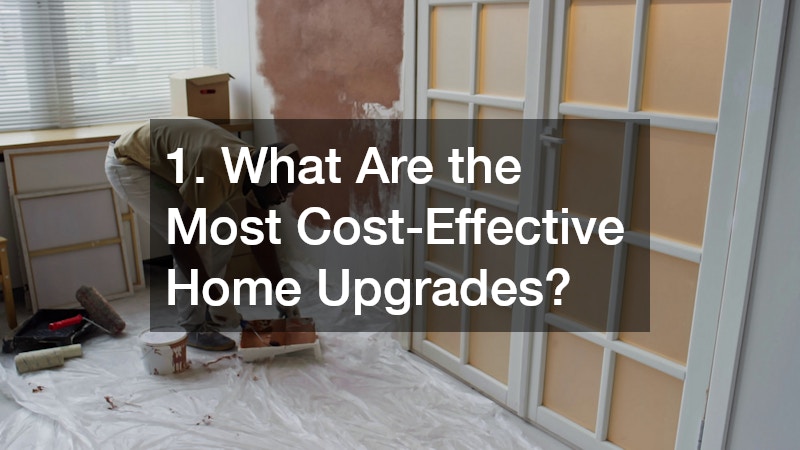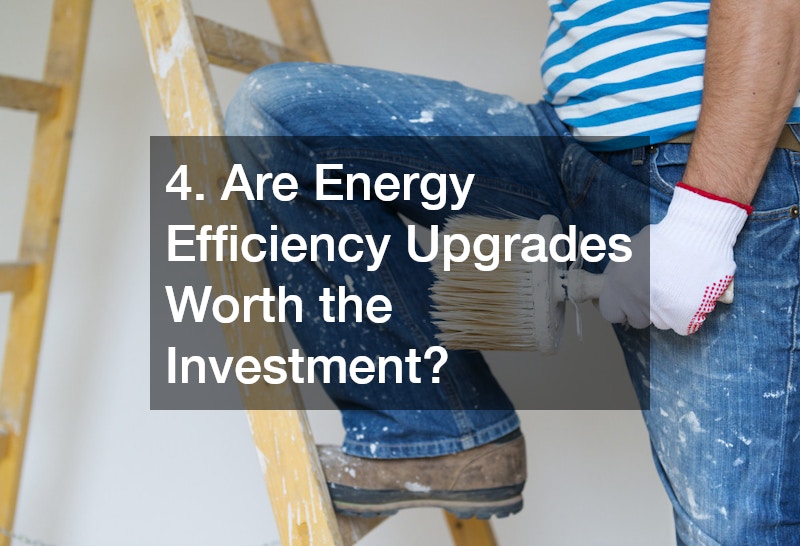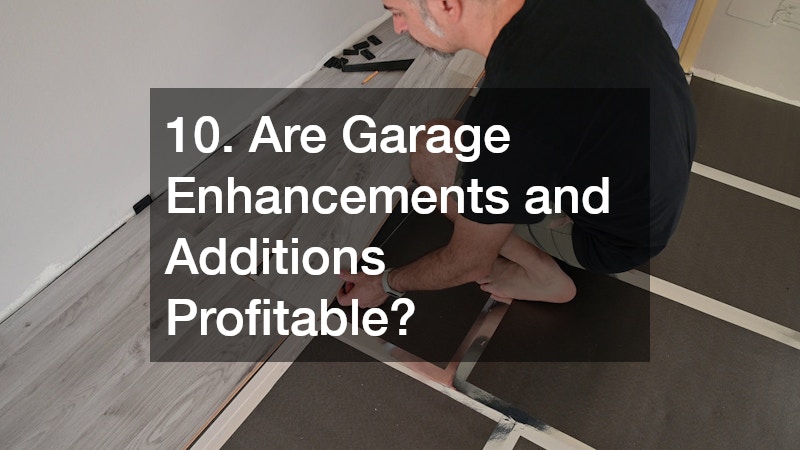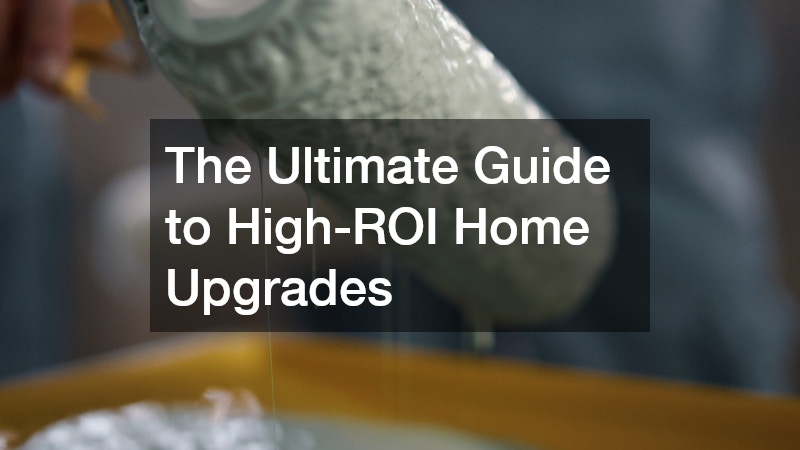In today’s housing market, homeowners are increasingly focused on making improvements that not only enhance their comfort but also deliver a strong return on investment (ROI). Whether you’re planning to sell your property in the near future or simply want to increase its long-term value, understanding which upgrades offer the best financial impact is essential. The right improvements can modernize your home, attract more buyers, and even reduce ongoing maintenance or utility costs.
This comprehensive guide explores the most effective home upgrades that deliver high ROI. From cost-efficient interior renovations to major exterior projects, we’ll break down which areas yield the most significant financial rewards. By exploring the details of each category, you’ll learn how to make strategic decisions that balance cost, functionality, and resale potential. Whether your goal is to refresh your living space or prepare for a profitable home sale, these insights will help you invest wisely and get the best possible returns.
Below, we’ll cover ten key topics and frequently asked questions about high-ROI home upgrades, including kitchen and bathroom improvements, energy-efficient installations, and exterior enhancements. Let’s explore which upgrades truly make a difference.
1. What Are the Most Cost-Effective Home Upgrades?

When homeowners begin planning improvements, it’s important to identify the upgrades that offer the best value for the least expense. Small-scale, cost-effective projects can make a surprisingly large impact on property value and buyer appeal.
Working with local concrete contractors is one of the most practical starting points. Concrete projects such as resurfacing driveways, repairing walkways, or adding patios provide both aesthetic and functional value. They enhance safety, prevent water pooling, and increase curb appeal—all at a relatively low cost compared to full-scale remodeling. Since first impressions matter greatly in real estate, clean, well-maintained concrete surfaces can immediately elevate a home’s exterior.
Other cost-effective upgrades include refreshing landscaping, replacing outdated fixtures, and improving lighting. Simple changes like installing modern door hardware or adding crown molding can provide a high return without the need for major renovation. Likewise, insulating attics or sealing windows can boost energy efficiency while lowering monthly utility bills—an appealing feature for future buyers.
Overall, focusing on affordable updates that improve both appearance and efficiency provides one of the best returns for limited budgets. These smaller investments often set the stage for larger, value-driving projects down the road.
2. Which Kitchen Upgrades Yield the Highest Returns?
Kitchen renovations consistently rank among the most profitable home improvement projects. However, not every upgrade offers the same return. The key is balancing aesthetics with practicality to appeal to a wide range of buyers.
Working with professionals experienced in epoxy floor services is one often-overlooked improvement that can dramatically enhance the kitchen’s appearance. Epoxy flooring is durable, easy to clean, and resistant to stains, making it a long-lasting choice for busy households. It also gives the space a sleek, polished look that complements both modern and traditional designs.
Beyond flooring, focus on updates that make the kitchen feel bright, functional, and inviting. Replacing outdated countertops with quartz or granite, upgrading to energy-efficient stainless steel appliances, and refinishing cabinets can collectively offer a strong ROI. Homeowners don’t necessarily need a full remodel—sometimes refacing cabinets and updating hardware achieve the same visual impact for less cost.
Lighting also plays a major role. Installing under-cabinet lighting or pendant fixtures above islands can make the kitchen feel larger and more welcoming. With careful planning, even mid-range kitchen upgrades can return 70–80% of their cost upon resale, making this area one of the smartest places to invest.
3. How Does Updating Bathrooms Increase Property Value?
Bathrooms are another high-impact area when it comes to ROI. Potential buyers often pay close attention to the quality and style of bathrooms, viewing them as indicators of the home’s overall condition.
Partnering with a local kitchen contractor who also specializes in bathroom renovations can help ensure cohesive design and craftsmanship throughout your home. Modern bathroom upgrades often focus on combining efficiency with comfort. Installing water-saving fixtures, adding a double vanity, or upgrading to a walk-in shower can greatly increase perceived value.
Tile updates, fresh paint, and improved ventilation systems also make a big difference. Replacing worn or outdated surfaces creates a clean, modern look that appeals to most buyers. For higher-end homes, adding features like heated floors or frameless glass showers can deliver an even stronger return.
Bathroom remodels typically recoup between 60% and 70% of their cost at resale, depending on the scope of the project. By focusing on timeless design and quality materials, homeowners can enjoy both daily comfort and solid financial value.
4. Are Energy Efficiency Upgrades Worth the Investment?

Yes—energy-efficient upgrades are among the most financially rewarding improvements homeowners can make. These enhancements not only reduce long-term utility expenses but also make a property more appealing in an increasingly eco-conscious market.
Replacing or resurfacing driveways with light-colored or permeable materials can even contribute to energy efficiency by reflecting heat and improving drainage. While driveways may seem unrelated to energy costs, they play a role in overall property management and sustainability.
Other impactful energy-efficient upgrades include installing double-pane windows, upgrading insulation, and investing in high-efficiency HVAC systems. Solar panels, programmable thermostats, and LED lighting are also proven ROI boosters. The added benefit of lower monthly energy bills makes these upgrades attractive to both current homeowners and potential buyers.
Energy efficiency improvements can yield an ROI of 60–80% and often qualify for government rebates or tax incentives, further improving their cost-effectiveness. Investing in green technologies not only supports long-term savings but also aligns your property with modern sustainability standards.
5. What Exterior Upgrades Boost Curb Appeal?
Curb appeal plays a critical role in determining property value. A well-maintained exterior creates a strong first impression and can make your home stand out in a competitive housing market.
Collaborating with excavation contractors can help homeowners address foundational and drainage issues before beginning cosmetic upgrades. Proper grading, soil stabilization, and drainage solutions protect landscaping and hardscaping investments while preventing costly water damage.
Once the foundation is secure, focus on visible improvements. New siding, a modern front door, or updated garage doors can greatly enhance appearance. Landscaping also provides excellent ROI—adding colorful plants, trimming overgrown shrubs, and keeping lawns healthy all make a lasting impact. Exterior lighting further boosts curb appeal while improving safety.
Power washing walkways, driveways, and exterior walls can instantly refresh a home’s look for minimal cost. These simple changes often recoup most of their expense, as they directly influence a buyer’s first impression. Investing in your home’s exterior is one of the most effective ways to improve value quickly.
6. Should You Consider Smart Home Technology?
Smart home features are becoming increasingly desirable for modern buyers. Integrating technology that enhances security, comfort, and efficiency can significantly increase your home’s appeal and ROI.
Before installing new systems, however, it’s important to address the home’s overall health. Professional mold remediations should be completed if any moisture or air-quality issues exist. Smart devices are most effective in clean, dry environments with reliable infrastructure.
Once the property is in good condition, homeowners can consider devices such as smart thermostats, lighting systems, and security cameras. These upgrades not only offer convenience but also demonstrate energy-conscious living. Smart door locks, motion sensors, and app-controlled appliances add perceived luxury and innovation to the home.
While some high-tech systems may lose value as technology evolves, basic upgrades like thermostats and security systems tend to hold their worth. On average, smart home features can add 3–5% to overall property value, making them a worthwhile addition for most homeowners.
7. How Important is Paint in Enhancing Home Value?

Paint remains one of the simplest yet most effective ways to boost home value. A fresh coat can transform outdated interiors and exteriors into modern, appealing spaces without major expense.
Before painting, homeowners should ensure there are no structural or environmental issues such as moisture or drainage problems. Consulting a septic system specialist may be necessary if foul odors or moisture seepage appear near the property, as these can affect both interior and exterior finishes.
Neutral tones such as soft grays, whites, and beiges tend to attract the widest audience. They make rooms appear brighter and larger, while providing a versatile backdrop for different styles of furniture. On the exterior, complementary trim colors can emphasize architectural details and create a cohesive, polished look.
Paint offers one of the highest ROIs of all upgrades, often exceeding 100% in resale scenarios. It’s affordable, fast to complete, and dramatically improves a property’s presentation—making it a must for any high-ROI improvement plan.
8. What Flooring Options Offer the Best Returns?
Flooring can influence both the functionality and aesthetic appeal of a home. Choosing durable, attractive materials provides comfort for residents and strong value for potential buyers.
Partnering with local siding replacements specialists can ensure consistency across all visible surfaces, both inside and out. A cohesive design from siding to flooring creates a seamless, high-quality impression.
Among flooring options, hardwood remains the most popular and profitable. Refinishing existing hardwood floors can yield nearly a 100% return, while installing new hardwood averages around 70–80%. Luxury vinyl plank and tile are also strong contenders due to their affordability, water resistance, and resemblance to real wood.
In high-moisture areas like basements or bathrooms, consider waterproof flooring materials that maintain visual appeal while providing durability. The right flooring choices not only improve daily living conditions but also enhance long-term property value.
9. How Do Finished Basements and Attics Add Value?
Unfinished spaces represent untapped potential in many homes. Converting basements or attics into functional living areas can provide one of the highest returns of all renovation projects.
Working with a custom bathroom contractor during the design phase can help ensure that added bathrooms or wet bars are installed safely and up to code. These additions significantly increase usability and appeal, particularly for large families or multi-generational households.
A finished basement can serve as an entertainment room, gym, or rental suite. Similarly, an attic conversion can create an additional bedroom or office. Both options add valuable square footage and make the home more versatile. Energy-efficient insulation and proper lighting can further enhance comfort and reduce long-term costs.
The ROI for finished basements and attics often ranges between 70% and 80%, depending on materials and layout. The key is ensuring the new space feels integrated with the rest of the home through consistent flooring, paint, and trim styles.
10. Are Garage Enhancements and Additions Profitable?

Garages often serve as multifunctional spaces for storage, work, and recreation. Enhancing this area can significantly boost both functionality and resale value.
Collaborating with swimming pool companies may seem unrelated at first, but professionals in this industry often have experience optimizing outdoor spaces. They can help integrate garage additions with backyard upgrades or pool areas for a cohesive, high-value property layout.
Simple garage improvements—such as adding insulation, upgrading lighting, or installing durable flooring—can make the space more comfortable and appealing. For homes without a garage, constructing one can deliver an ROI of up to 70%, particularly in suburban or colder climates where covered parking is in demand.
Homeowners can also consider storage solutions like custom cabinetry or overhead racks to improve organization. If space allows, converting part of the garage into a home gym or office can appeal to modern lifestyles. These enhancements not only increase usability but also make the home more attractive to buyers seeking flexible living options.
High-ROI home upgrades do more than just beautify a property—they create long-term value, comfort, and efficiency. Whether you’re resurfacing driveways, finishing basements, or investing in energy-efficient systems, each improvement plays a role in building lasting appeal. Strategic planning and quality workmanship are essential to maximizing returns, as even modest upgrades can produce meaningful results when executed properly.
By working with trusted local professionals—from concrete contractors to custom bathroom specialists—homeowners can ensure durable, visually appealing results that stand the test of time. Ultimately, focusing on thoughtful, high-ROI improvements turns your home into not only a more enjoyable place to live but also a stronger financial asset.


